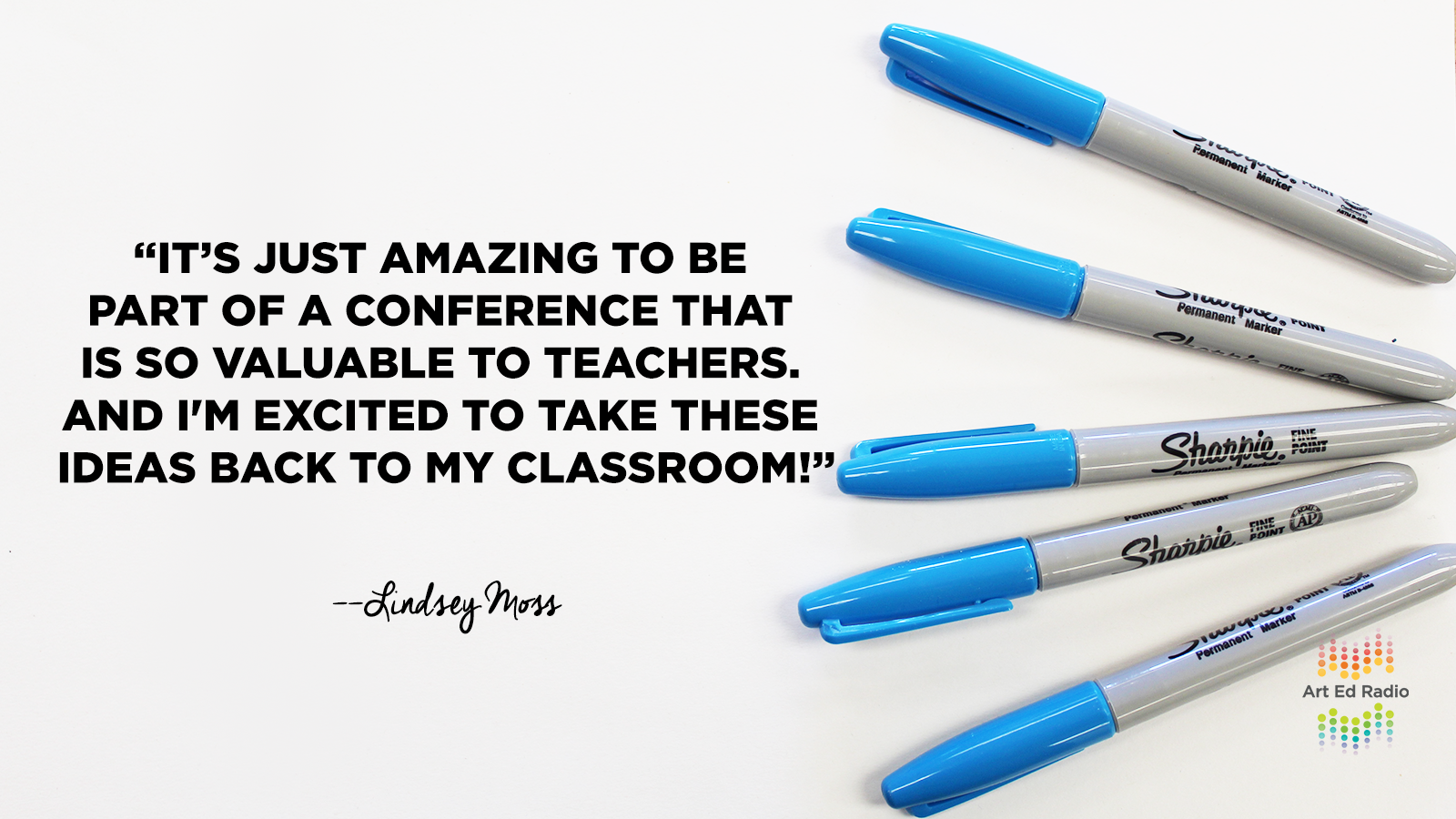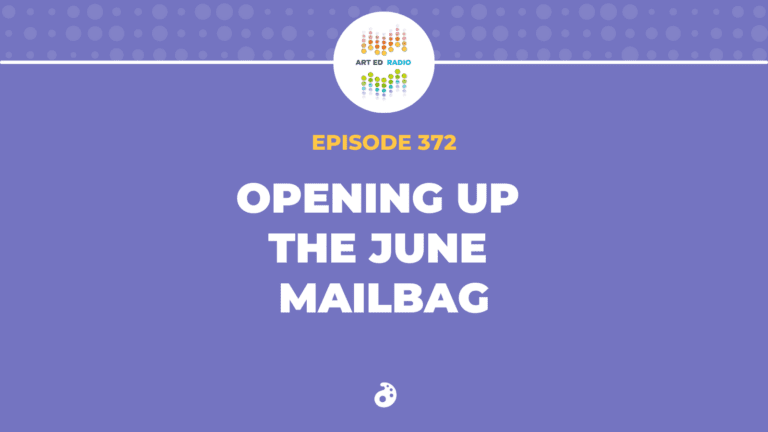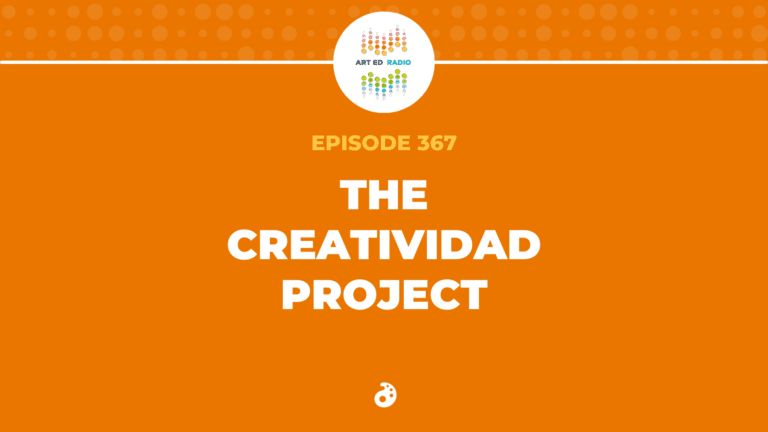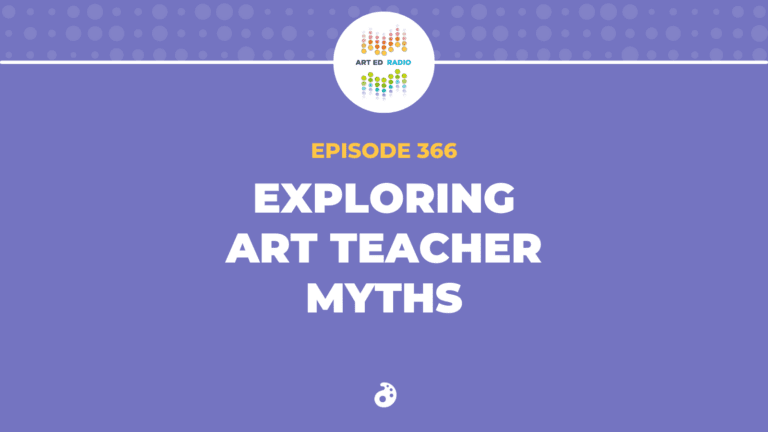The 2019 Winter Art Ed Now conference is in the books, and Tim is here with Lindsey Moss break it all down! Listen as they discuss their highlights from the conference, their new love for Paul Topolos and appreciation for Pixar, and their a-ha moments and takeaways from the presenters. Full episode transcript below.
Resources and Links
The Winter Conference Recap is Here
The Paul Topolos Podcast Interview
If you missed this conference, there’s always the next one!

Transcript
Tim: Welcome to Art Ed Radio, the podcast for our teachers. This show is produced by the Art of Education University and I’m your host Tim Bogatz.
Now I am sitting here at AOEU Headquarters all by myself recording this after a long day, but an amazing day at our Winter 2019 Art Ed Now Conference. It was another great conference. I’m really happy with how everything went. There are some awesome highlights. We had some really cool presentations, some amazing new presenters, and a great keynote from Paul Topolos, just kind of taking us behind the scenes at Pixar, talking about all the work he’s done as an animator on all of these amazing movies.
It’s always a great feeling for me to be able to share those types of interviews, those types of presentations with our teachers everywhere, and because of that, it’s always a great feeling to get through a conference, but at the same time, it’s kind of a strange feeling because I’ve been working on this conference, been putting together this conference for six months, and then all of a sudden, it’s done in a day.
I think it was successful. We’ve had a lot of positive feedback throughout the day, and I feel really good about what we were able to put together. We’re not gonna spend a lot of time dwelling on the conference because we’ve already started working on the summer one full steam ahead on the next one.
As we ask our students to do all the time, I like to reflect on what went well, what needs some improvement, and just kind of what ways we can make the conference better. I’m gonna talk to Lindsey Moss here, gonna call her up and we’re just gonna chat a little bit about how the day went, spend some time reflecting, and just kind of see, bounce some thoughts off of each other and see maybe what we can do to improve for next time as well.
Let me give her a call, and we will get her on soon.
All right, and Lindsey Moss here to join me to recap the conference. Lindsey, how are you?
Lindsey: I’m good. Thanks for having me, Tim.
Tim: Hey, well thanks. I feel like we did this over the summer. You were part of the recap, and again, you ran the chat for us, very well, I might add. I think it’s good to kind of rehash things as we get done with the conference. I guess the biggest question, the first question is what were your overall thoughts on the conference? Did it live up to the hype for you, or did you get everything you needed from it?
Lindsey: Oh, my God. Absolutely. I felt like it was such a good mix of new presenters that were really talented, and then old favorites offering new perspectives. The presenters were fabulous. I felt like the topics were really good this time around too. There’s so much going on in classrooms with social-emotional learning right now. It’s just become such an integral part of the current classroom dynamic, and I felt like it was a common thread through a lot of the sessions.
I know people have been asking for art therapy and finally, we had Jesse Armstrong with a session just on that, so that … and I couldn’t get over the swag box either. I was lucky enough to register in time and get a swag box this time around, and that thing was full. There were so many creative, cool things, even the cocoa in the coffee mug this time around.
Tim: That was so popular. Everybody loves their hot chocolate, so that was nice.
Lindsey: Yeah.
Tim: Yes, but just like even, as you said, the amount of stuff in the swag box was incredible. I feel like when they were packing those, it was like a puzzle putting together, ’cause I just opened mine up and stuff just like spilled out everywhere. It was so packed.
Lindsey: That’s to play Tetris. Absolutely.
Tim: That’s a good way to put it. But no, there is a lot of great stuff in there. Let me ask you this, do your kids at home, do they raid your swag box before you can go through it?
Lindsey: Sometimes they try. This time I kind of opened it when they weren’t home to prevent that, so I could at least go through it once before they start ripping everything open and getting it everywhere.
They were particularly drawn to that lesson plan and bookmark from Art to Remember that had the rainbows on it and everything. That was the first thing my third grader picked up. She’s like, “Are there colored pencils in here?” She was excited.
Tim: Yeah, that was awesome. I think Amanda O’Shaughnessy who did that presentation did an awesome job, just by taking a fundraiser and making it interesting. A lot of times people tend to stay away from those because everything turns out the same. You have every class doing a different product even, but you still have things that look so similar.
She has a totally new take on it with turning it into coloring book pages and giving ideas on how to make it individualized. I thought not only were the rainbows awesome, that was a really, really cool way to go about the fundraiser.
Lindsey: Yeah, a smart strategy for more choice. I like that.
Tim: Yeah, for sure. You mentioned the presenters and I was super excited about the lineup. Just being in charge of the conference, putting everything together, I love seeing it come together and I really liked the lineup. I wanted to ask you, we had a few returning presenters who were all awesome.
Rachel Albert, Don Massey, Lena Rodriguez, Debbie West, Wynita Harmon, who did you really like out of there, and it’s okay to pick favorites. They won’t mind. Who did you like out of there and why?
Lindsey: Oh man, it’s hard to pick the favorite. I always love what Debbie and Wynita have to say, but I feel like this time around what Rachel Albert was speaking to just really resonated with me.
My district went one-to-one with our fourth graders, I guess it was last year now. A lot of the classroom teachers are dabbling with Google Classroom, and I hear them talking in the lounge all the time about how it’s been really effective for them. I had the hardest time wrapping my head around how you would do that with hundreds of kids.
I know kind of the basics of how you set the classroom up and stuff, but I just thought that when Rachel took that deeper dive, when she was showing the demo video, first of all, I was cracking up with her hilarious example, that footage of all the kids just freaking out in the classroom like that.
Tim: Yes.
Lindsey: I could relate to this. But then she made it so approachable that you don’t have to have a video for every lesson, just the ones that are really instruction-heavy. I loved her idea about artists statements, and then this idea that you could give extra assignments to your early finishers. That’s the best differentiation plan I’ve heard in a long time.
I feel like after hearing that, I kind of feel more empowered to really give it a try in my school. My principal will love that too. So yeah, I think Rachel’s was my favorite from our returning friends.
Tim: Yeah, that’s really cool. I feel like Rachel does such an amazing job each time. She’s done the stop motion animation before, just like packing so much information into a presentation, but still making it, like you said, approachable and gives you all of these amazing takeaways.
I feel like we need to just keep asking her back to do amazing things.
Lindsey: Me too. She’s awesome.
Tim: And then the other thing that kind of made me nervous, again, just putting this lineup together, three-fourths of the people I think were brand new, had never presented before, and that makes me nervous because you never know exactly what you’re gonna get.
I felt like we came through with some really good stuff. Out of the new faces, was there anybody that really stood out to you? Anybody that really shined?
Lindsey: I felt like there were a lot of cool new perspectives, but my absolute favorite by a stretch was Sarah Gector.
Tim: Yes.
Lindsey: She had me at the hello on her spraypainted wall. First of all, I loved that she actually took to the streets to present. That was so cool. Then I feel like I’ve seen graffiti presentations before, but I was really surprised at her content. I guess I had never thought about sticker tagging or this idea of bees wheatpaste poster before.
I was thinking of graffiti as a really narrow definition, and so when she broadened it to be these other projects, man, I feel like I could really engage my fifth and sixth graders with that.
I also loved, anytime you bring up graffiti, people are concerned about the legality and the intention, and I love how she just comes right at it with her kids. It’s just part of the discussion.
Tim: Yes.
Lindsey: Yeah, just a different opportunity for my kids to talk about social issues, which I feel like is becoming more and more important to them. I loved hers.
Tim: Yeah, I’ve been super impressed with her. I actually ran into her in Seattle at NAEA last year, and that’s where I first found out about her, saw what she was doing. I saw her presentation, and like, “Whoa, she is special.”
She came on the podcast and did an amazing job there. I’m like, “Let’s put a conference presentation together,” and yeah, like you said, I’ve never had anybody record all over the city, so that was pretty cool, and just seeing graffiti from incredibly famous street artists. Seeing pieces from them was really cool. I thought that was a good effect.
The other one that I really liked was Mallory Tolcher. She did the community connection and painting the basketball courts. We always think about community art, but her sort of guidelines as far as, here’s step one to get you started, here’s step two and just taking you piece by piece through how you can create those connections and how you can create those artworks, I think is really impressive. That whole hour about reaching out to a community was just awesome.
Then I wanted to also ask you about our keynote, Paul Topolos. Personally, I loved seeing all the behind the scenes looks at the Pixar stuff and just hearing about some of his working methods and movies he’s worked on. I guess a two-part question, what did you think personally, and then secondly, as you’re running the chat, what was the general consensus there?
Lindsey: Well personally, I could listen to Paul talk all day.
Tim: Yes.
Lindsey: Just really mellow demeanor, and then at the same time is showing you this work that is so unbelievably powerful. It was really cool. That was the general sense that I got from the chat too. I feel like he’s such an interesting artist to pick because he connects so directly with our kids, and has done so much animation, and video game work.
In the chat, it seems that teachers really appreciated that perspective, because it’s something that their students are interested in the potential for a career. Of course, everybody wants to talk about what their favorite Pixar production is. Do you have a favorite?
Tim: Do I have a favorite?
Lindsey: Yes.
Tim: I have a couple, but I think Inside Out might be my favorite. Paul talked a lot about storytelling and the aspect of that, and I don’t know that the animation for Inside Out is quite as exciting as some of the other movies, but the storytelling and the concept of that are just incredible.
It might be because my daughter’s right about the same age as the main character and going through a lot of those things right now, but yeah, I think that’s my favorite. What about you?
Lindsey: That’s a hard pick. It’s between Ratatouille and WALL-E. I just really love WALL-E a lot. I feel like it’s almost two separate movies, and it was just really cool. I guess I had never stopped to think about the animated process for WALL-E, and I didn’t realize that some of those trash heaps were still paintings.
Tim: Yes.
Lindsey: I feel like he just said so many powerful things tucked into like 10 minutes there. I didn’t … you know, it’s neat when you hear about somebody who came from a teaching background. Didn’t he mention his mom and his grandmother had been teachers?
Tim: Yes, and a couple of his cousins are professors, so he had a really good appreciation for education. He touched on that a lot in his presentation, which as you said, I think was really powerful.
Lindsey: My biggest takeaway from his, I wanna make a sign for my classroom with his quote. He said, what was it, something like art is a language we all know how to read, but don’t necessarily know how to write. I thought man, there is no better reason for a kid to be in the art room. I need to make a giant poster or sign that says that for my door. I just loved Paul. He was great.
Tim: Yes, I agree. He was the nicest guy ever. I talked about this a little bit in his podcast when he was on a couple weeks ago. He was in San Francisco, invited me and the whole video team to his house to do a shoot. He saved parking for us, he made breakfast for everybody, and he’s just like, I don’t know, the nicest guy ever, which is awesome.
You mentioned Ratatouille, and he was so proud of that movie because he just loves to cook, and his bookshelves are just filled with all of these crazy cookbooks on like the theory of pastries and all sorts of great stuff. I feel like-
Yeah, you could tell he was most proud of his work on Ratatouille.
Lindsey: Okay, so Tim then, was the breakfast pretty good?
Tim: It was amazing. Yeah, I got there first before the video team, and Paul’s just in there cooking sausage and he had all these pastries for us, and gourmet bacon. It was amazing. Then he’s got four different coffee machines. He’s like, “Do you guys need a cappuccino? Do you want a latte? I can do-“
Lindsey: Four different coffee machines? This is my kind of breakfast.
Tim: Yeah, so it was pretty amazing. That’s nothing that a keynote has ever done, and probably will never do for us ever again, but it was amazing.
Okay, but we probably need to move on. Nobody wants to hear about breakfast for too long on a podcast. I was just kind of thinking we’re an hour removed from the conference, and already I’m starting to think about the next one because that’s just kind of how we roll, but what do you think we need to see more of next time around? You mentioned Jesse Armstrong, because people have been asking about art therapy forever. We finally have a presentation there. People have been talking about getting a Pixar animator as the keynote, we’re finally able to put that together.
Do you think there’s anything that’s still out there that we’re missing and really need to cover or anything that you think we need to talk about more?
Lindsey: Well, I don’t know. I feel like the conference balance is always really good. I mean, we can talk about art stuff for infinity. I feel like the summer conference for me is so different for me from the winter conference. The winter conference is like this totally necessary recharge, you know, and in more of the year when you’re kind of feeling exhausted and your gas tank is low, but then the summer conference is the opposite. You’re getting all these crazy ideas that you wanna try out in your classroom for the fall.
I think, I especially for the summer conference love ideas that are really kind of on the edge, or something really new and different when it comes to technique. I think though, honestly, for the last several conferences my very favorite part has been these artist keynotes, whether it was Jen Stark or Alexa Meade, I just love hearing these perspectives about how these people got to where they were and how our education kind of affected them.
I’m excited to find out who we’re gonna have next time.
Tim: Yeah, so you’re putting the pressure on me to find an awesome keynote is what you’re saying?
Lindsey: That’s what I’m saying, Tim.
Tim: Sounds good. I think you make a good point, though, the winter conference is all about just kind of hanging on. Just like we’re barely getting through this, but just kind of recharges your batteries and it really gives you a push you need to get through the last couple of months.
Then the summer conference is just filled with optimism. Everybody’s been off for a few weeks. We’re excited to get back at things. We’re more open to those new approaches, ’cause like if somebody’s got something really cutting edge in August, you’re like, “Yes, this is gonna be amazing,” and if you see that in February, you’re like, “Oh, too much work. I can’t do that.”
Lindsey: Absolutely the truth.
Tim: So yeah, we like to think about that approach as we go through. I said August, but I think Greg may actually move it to July this summer because for I don’t know what reason, a lot of school districts think they need to start on like July 31st or August 1, which is crazy to me.
Lindsey: Oh yeah, we’re in August this year,
Tim: Yeah, it’s rough. So anyway, we’ve had people having to miss the conference because their school district is starting so early. I think we’re gonna try July, which hopefully will help people out.
Before we wrap up before we move on to that as I said, we’re immediately thinking about the summer conference, and we need to talk about your dramatic return as a presenter. Can you just kind of share with us what you’re planning for summer presentation?
Lindsey: Well sure, yeah. Like I was saying about my philosophy about the summer conference, I’m looking for something that’s gonna get me excited and organized for the fall, and in my personal teaching practice, that has been sketchbooks. I feel like sketchbooks are everything for my kids. It’s like a way to teach mindful planning, a way to emphasize process over product, a way to give them a comfortable testing ground where failure is kind of something that’s okay.
It’s so hard to implement a system like that for 500 kids plus, with fidelity and on a budget. I’m doing a second implementing sketchbook with sanity. I’m gonna share the system that’s working in my school that’s running semi self-sufficiently that is really cheap and low-cost that includes some assessment strategies that get the kids involved in some formative assessment so that you are not wasting a ton of time grading 500 plus sketchbooks.
Then some sketchbook prompts there are working for even my kiddos who are super-reluctant drawers. I like doing the giant download. That’s like-
Tim: Yes, that’s your calling card.
Lindsey: Yeah, I love that. I like to go to a session and have something in my hand and I can print the very next day and take to school, so that’s what I’m gonna try and do.
Tim: Yeah, that’ll be really cool. I feel like that follows up Debbie’s presentation, what she talked about with assessments and visual journals. I think that’ll be good. As you said, it’s a lot of work to implement ideas for 400 or 500 kids, so it’s perfect for the summer, just like we talked about.
Lindsey: Yes.
Tim: I think we’ll be in good shape. I think we’ve been talking too long, so we better go ahead and wrap it up, but Lindsey, thank you so much for all of your help with the conference. Thank you for running the chat, and thanks for coming to talk about it with me on the podcast. It’s been good.
Lindsey: Yeah, thanks for having me.
Tim: Thank you to Lindsey. Also a big thank you to everyone who participated in putting on the conference. Big thank you to the presenters and thank you to everyone who attended.
I love the community that is part of this conversation. The chats during the conference, of course, it’s amazing to talk to hundreds of other art teachers, but also the discussions that take place on social media, the sharing of all of the pictures, people attending with their colleagues or their pets or whatever.
It’s just great to see how everybody’s taking this in. I love seeing the discussion on the Art Ed Now attendees Facebook page. All of these things are gonna keep going, even after the conference is over.
Make sure you check out the after pass if there’s anything you need to see again, and also go sign up for the summer conference. You can go to ArtEdNow.com. Check out the presentations we’ve already released including Lindsey’s that she just talked about.
You can lock in your early bird prize for the next conference. More importantly, if you sign up now, you are guaranteed a swag box. You know that the conference is going to be great. You know that you wanna sign up, so just go do it.
We will hope to see you there, and I’m going to do everything I can to make sure that the summer conference is another amazing experience.
Art Ed Radio is produced by the Art of Education University with audio engineering by Michael Crocker. Thank you for listening. Thank you for coming to the conference. I hope it was a worthwhile and exciting day of professional development for you.
Shannon Lauffer wants to come back on the show. I always love having her as a guest, so we’ll see what we can do and hopefully get her on in the next couple of weeks. We’ll talk to you soon.
Magazine articles and podcasts are opinions of professional education contributors and do not necessarily represent the position of the Art of Education University (AOEU) or its academic offerings. Contributors use terms in the way they are most often talked about in the scope of their educational experiences.



